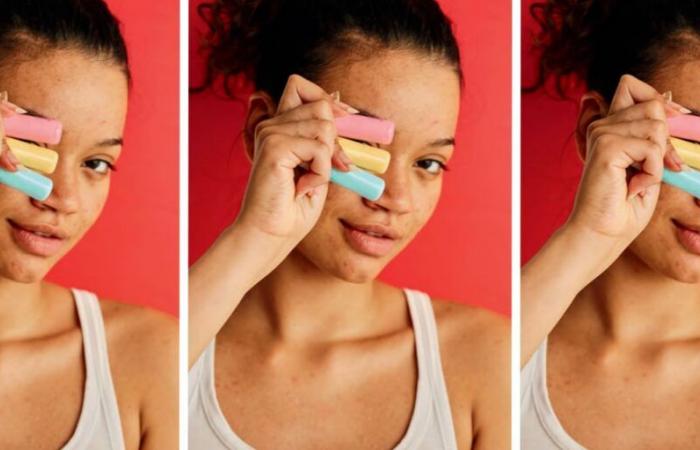What would a dermatologist advise his young offspring if they were captivated by the song of very elaborate beauty routines? This is a question that many parents are asking themselves with the rise of the “Sephora kids”, children and pre-teens who spend a fortune on serums, masks and cosmetics of all kinds (supporting purchasing videos). Dr. Julia Carroll, a dermatologist and mother of a 13-year-old daughter, took a strategic approach. “I designed a skin care routine especially for her, to apply morning and evening, and I made a PowerPoint presentation,” says the expert, who practices at the Toronto clinic Compass Dermatology. “I included questions like, “Would you prefer this or that?” to give him choices — but controlled choices.”
Let’s talk about control. One of the most “liked” TikTok videos in the #SephoraKids directory is that of a Sephora employee who relates — and deplores — the story of a mother who “succeeded” in reducing her daughter’s basket from $900 to $500a sum which nevertheless remains astronomical. “Excuse me, but who is the mother here?” asks this outraged TikToker. It’s easy to judge, but any parent knows how much easier it is to be overwhelmed, especially in the age of viral trends. “Even if young people have a mother who is a dermatologist, they are influenced by what they see on TikTok or Reddit,” says Dr. Carroll.
The specialist notes that this trend has spread like wildfire among her patients over the past year. “I see a lot more teens and preteens who, in my opinion, have overly complex skincare routines. and who use ingredients that I would not recommend for their skin or skin concerns.”
Knowledgeable parents like her have a competitive advantage when it comes to managing their children’s obsession with cosmetics, making them valuable resources for others. So we asked Dr. Carroll to explain to us what a preteen’s skincare routine should look like (or not). It’s not new that what’s hip among young people raises moral questions. Fortunately, Dr. Carroll believes that in this case, there is no need to panic. “I don’t like to be alarmist. It’s just that it can be a waste of money and time,” she says, emphasizing thatthere is no benefit to starting to use anti-aging treatments in early adolescence. “I see 12- and 13-year-olds incorporating vitamin C into their routine, and I really don’t think they need it.”
The same goes for other trendy ingredients like retinol, known for its dual ability to treat both wrinkles and spots — and for its irritating potential! “When someone is prone to acne, I often prescribe retinol, but it is not necessary in all cases or for all skin types.”
The brands popular with young people have themselves recognized this. For example, the company Drunk Elephant, with colorful packaging and whose products have funny names. This brand, one of the most popular with this segment of the population, reacted to this craze by publishing a message from its founder, Tiffany Masterson, on Instagram. It states: “Most of our products are designed for all skin types, including children and pre-teens.” However, she adds: “I advise avoiding our strongest products, which contain acids and retinol, because these young people’s skin does not yet need these ingredients.”
The more you expose your skin to active ingredients and powerful perfumes, the more you risk making it sensitive.. This partly explains the anxiety caused by very elaborate routines. “I also tell my older patients: If you use too many products and you have a reaction, you won’t know what you’re reacting to,” adds Dr. Carroll.
That said, even in the absence of skin irritation, in the current economic context, who wants to finance the unnecessary care of a 10 year old child? One of the rules that Dr. Carroll established with her daughter may prove useful: the latter had to commit to following the same routine for six to eight weeks, “instead of constantly changing products, which is bad for the skin as well as the wallet.” The dermatologist can’t help but give the following advice: “Parents should lead by example with their own skin care, because that’s about how long it takes to see results with the most products.” If we wanted to find a positive side to our “Sephora kid” hobby, Dr. Carroll has other words of wisdom for us: “I think, to a certain extent, it comes down to a desire to take care of yourself . I like that young people who come to my office listen to the advice of an expert and commit to a skin care routine, which can benefit them if they are undergoing acne treatment, for example. example.”
Let’s also remember that each generation has its own way of playing adults. “When I was a teenager, Sephora and the Internet didn’t exist, but I had books and magazines,” remembers Dr. Carroll. I made masks based on oatmeal or egg white and exposed my face to steam baths!”
But then, what should the care routine for children or tweens look like? According to the specialist, most children and pre-teens do not need skin care (apart from sunscreen!), but if a resounding no isn’t enough, you can try to find common ground with your young “Sephoraficionado.” “The routine should be pretty simple,” says Dr. Carroll. “It’s important to remember that every skin is different — what’s good for acne-prone skin can be disastrous for eczema-prone skin — and that corrective action may be necessary. But the basics I recommend below are a great place to start.”
1. MILD CLEANSER
Although the ideal formula may vary depending on each skin’s needs (for example, oily skin can handle a mousse, while dry skin may need a gel), Dr. Carroll recommends choosing a product with the ingredient list is short. “The classics, like Cetaphil, CeraVe or La Roche-Posay, are safe bets,” she says, adding that people prone to acne can choose a medicated cleanser containing salicylic acid or peroxide. benzoyl.
2. PRESCRIBED CARE OR TREATMENT (IF NEEDED)
“If your child has acne or eczema and has been prescribed a prescription product, it should be applied.” You must carefully follow the doctor’s or pharmacist’s instructions, as certain ingredients (such as retinol) should preferably be applied in the evening, to avoid exposure to the sun. “Retinol should be used with caution; that’s why I prefer young people to consult a dermatologist.”
If your son or daughter is experiencing breakouts and is not taking prescription treatment, he or she can use a drying lotion, medicated pre-soaked pad, anti-acne gel or lotion. “In the case of spot treatments, most acne products are designed to be applied to the entire affected area,” recalls the specialist. For example, it is better to treat the entire forehead, nose or chin rather than just the surface of a pimple. “If you just apply the product to spots when they appear, you will never get rid of them.”
3. SERUM (TOTALLY OPTIONAL)
Does a preteen or teen need a serum? “No, but they love it,” Dr. Carroll said with a laugh. If you want to compromise, she suggests choosing a product containing hyaluronic acid. “This product can act as a moisturizer and I don’t see a problem with it, even if I’m not convinced that these young people need it. Niacinamide, a popular ingredient, may also be a good choice. It’s a form of vitamin B3 that has several effects.” The most interesting for young people? “It can help reduce inflammation or redness from acne.
4. MOISTURIZING TREATMENT
Our skin’s ability to maintain hydration decreases with age. Although moisturizer is not essential for younger people, it can be beneficial during dry months or when acne treatment is taking its toll on their skin’s protective barrier. As with cleansing treatments, the appropriate product depends on skin type. Oily skin prefers light gels, dry skin benefits from creamier gels. “Again, I favor the classic brands sold in pharmacies,” says Dr. Carroll.
5. SUN PROTECTION
Sun protection is the first real non-negotiable tip on the list! Protecting your skin from the sun every day is imperative for anyone over six months of age (before that, the official recommendation is to avoid all exposure to the sun). There are a multitude of formulas, but you must make sure to choose broad-spectrum protection (that is, one that protects against both UVA and UVB rays), which includes a sun protection factor (SPF). ) of at least 30. Many facial moisturizers contain SPF. Dr. Carroll has nothing to say about this, as long as the minimum SPF is respected and the treatment is applied generously to obtain the expected protection. Sun care uses mineral or chemical filters with different protection mechanisms for the skin. “Both do the trick,” she assures. It then depends on our personal preferences (chemical filters often look more invisible, but can also be more irritating for hypersensitive skin).
But there are undoubtedly other safe and pleasant ways to get started with skin care. For young cosmetic care enthusiasts, following a minimalist routine is not necessarily always fun. Helping them get out of this framework from time to time can be an opportunity for parents to bond with them, or simply to please them. Gentle sheet masks are a great way to give them a little treat and spend some relaxing time with them. “Hyaluronic acid masks are great,” exclaims Dr. Carroll. If spots are a problem, hydrocolloid patches can calm the urge to scratch and promote healing. There are even some with fun designs, which encourage young people to adopt a positive attitude towards acne by helping them take responsibility for their spots instead of desperately trying to hide them.
To make informed decisions, do not hesitate to consult your dermatologist or follow certified dermatologists on social networks who will provide you with a wealth of useful information. “You must also resist the temptation to stop by a Sephora store too often,” recalls Dr. Carroll. We can even create a reward table to encourage your young people to respect the six to eight week deadline.” For parents, she adds, where possible: “Don’t worry too much. It’s just the latest fashion trend, but these are similar behaviors to what we had when we were younger.”






